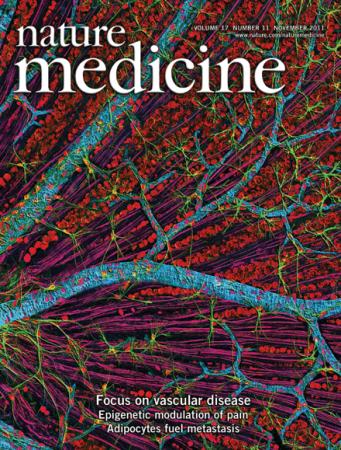美国研究人员近日声称,对抗癌症方面,光波是“大有可为”的工具。
据报道,发表于《自然—医学》(Nature Medicine)的一项研究显示,科学家可研制一种附着在肿瘤上的药物,而这种药物只有得到一种特定波长的光照到时才会活化。这表示该疗法可以十分精确地锁定在治疗目标上,且不会破坏周边组织。
一个癌症慈善团体说,这项疗法在开始阶段就“大有可为”。
据悉,目前的癌症疗法可分成三类:辐射摧毁癌细胞,手术移除肿瘤,或是使用药物杀死癌细胞。这些方法都有副作用,因此科学家正试图想出更精确的疗法。
在这项研究中,美国马里兰州的国家癌症研究所研究人员使用一种抗体,将目标锁定在癌细胞表面的蛋白质。接着,他们在抗体上加上一种化学药品IR700。 IR700在近处的红外线照到时会活化。这种波长的光线可以渗透到皮肤下好几公分。
为了测试这种抗体与化学药品的结合疗法,研究人员将鳞状上皮细胞癌的肿瘤移植到老鼠背部。研究人员会给予老鼠药物,并让它们暴露在近处红外线的光线。
研究称:“比起未接受治疗的控制组老鼠,这些老鼠的肿瘤体积大大减少,存活率明显增加。这种选择性的杀害方法,可以让正常细胞的受损程度降到最低。”
作者说,这种结合是“癌症疗法大有可为的治疗与诊断手段”。
不过,研究人员也表示:“虽然在我们的实验中没有观察到毒性 ,但这种方法的在临床上还是需要正式的毒性研究。”(生物探索)
相关英文论文摘要:
Cancer cell–selective in vivo near infrared photoimmunotherapy targeting specific membrane molecules
Three major modes of cancer therapy (surgery, radiation and chemotherapy) are the mainstay of modern oncologic therapy. To minimize the side effects of these therapies, molecular-targeted cancer therapies, including armed antibody therapy, have been developed with limited success. In this study, we have developed a new type of molecular-targeted cancer therapy, photoimmunotherapy (PIT), that uses a target-specific photosensitizer based on a near-infrared (NIR) phthalocyanine dye, IR700, conjugated to monoclonal antibodies (mAbs) targeting epidermal growth factor receptors. Cell death was induced immediately after irradiating mAb-IR700–bound target cells with NIR light. We observed in vivo tumor shrinkage after irradiation with NIR light in target cells expressing the epidermal growth factor receptor. The mAb-IR700 conjugates were most effective when bound to the cell membrane and produced no phototoxicity when not bound, suggesting a different mechanism for PIT as compared to conventional photodynamic therapies. Target-selective PIT enables treatment of cancer based on mAb binding to the cell membrane.
英文论文链接:https://www.nature.com/nm/journal/vaop/ncurrent/full/nm.2554.html








